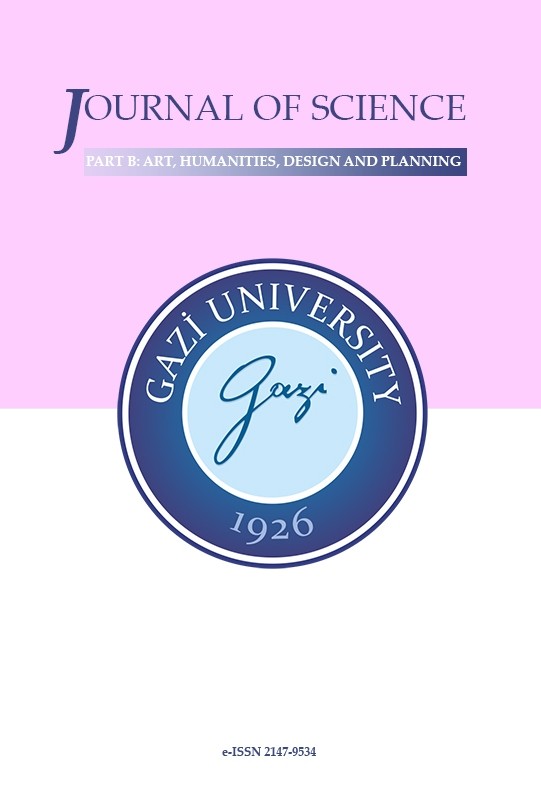Moldings on Facades until the End of the Classic Period in Ottoman Architecture
Moldings on Facades until the End of the Classic Period in Ottoman Architecture
Ottoman Architecture, Facade Layout Facade Elements, Moldings,
___
- [1] Kuban, D. (2004). Mimarbaşı Koca Sinan: Yaşadığı Çağ ve Eserleri. İstanbul: Vakıflar Genel Müdürlüğü.
- [2] Ersen, A. (1986). Erken Osmanlı Mimarisinde Cephe Biçim Düzenleri ve Bizans Etkilerinin Niteliği.. İstanbul: İTÜ Yayınları.
- [3] Kuban, D. (2016). Osmanlı Mimarisi. İstanbul: Yapı-Endüstri Merkezi Yayınları.
- [4] Aslanapa, O. (1986). Osmanlı Devri Mimarisi. İstanbul: İnkılap Kitabevi.
- [5] Baydar, L. (1999). Klasik Dönem Osmanlı Kamu Yapılarında Estetik Ölçütler. In G. Eren (Ed.), Osmanlı: Cilt 10 Kültür ve Sanat. Ankara: Yeni Türkiye Yayınları, 57-64.
- [6] Necipoğlu, G. (2013). Sinan Çağı Osmanlı İmparatorluğunda Mimari Kültür. İstanbul: İstanbul Bilgi Üniversitesi Yayınları.
- [7] Erzen, J. (1981). Mimar Sinan Dönemi Cami Cepheleri. Ankara: ODTÜ Mimarlık Fakültesi Basım İşliği.
- [8] Yetkin, S.K. (1965). İslam Mimarisi. Ankara: Ankara Üniversitesi Basımevi.
- [9] Baydar, L. (1986). Batı Tesirine Kadar Osmanlı Mimarisinde Estetik Kriterler. Doctoral Thesis. Ankara: Gazi Üniversitesi Fen Bilimleri Enstitüsü.
- [10] Demiriz, Y. (1979). Osmanlı Mimarisinde Süsleme 1, Erken Devir (1300-1453). İstanbul: Kültür Bakanlığı.
- [11] Demiriz, Y. (1988). Sinan Mimarisinde Bezeme. In Mimarbaşı Koca Sinan Yaşadığı Çağ ve Eserleri. İstanbul: Vakıflar Genel Müdürlüğü, 466-474.
- [12] Özbek, Y. (1999). Erken Osmanlı Mimarisinde Taş Süsleme. Doctoral Thesis. Ankara: Hacettepe Üniversitesi Sosyal Bilimler Enstitüsü.
- [13] Binan, M. (1952). Türk Saçak ve Kornişleri. İstanbul: İTÜ Mimarlık Fakültesi.
- [14] Batur, A. (1974). Osmanlı Camilerinde Kemer: Strüktür Biçim İlişkisi Üzerine Bir Deneme (1300-1730). İstanbul: İTÜ Mimarlık Fakültesi.
- [15] Ödekan, A. (1988). Kütle Biçimlenişi Ve Cephe Düzenlenmesi. In Mimarbaşı Koca Sinan Yaşadığı Çağ ve Eserleri. İstanbul: Vakıflar Genel Müdürlüğü, 513-520.
- [16] Ögel, S. (1990). Şehzade Mehmet Camii'nin Dış Yan Sofaları. Vakıflar Dergisi, (21), 151-164.
- Yayın Aralığı: Yılda 4 Sayı
- Başlangıç: 2013
- Yayıncı: Gazi Üniversitesi
Medieval Wall Painting in Bosnia and Herzegovina
A Method Proposal for Evaluation of Shopping Centers Regarding Standards Related with Accessibility
Moldings on Facades until the End of the Classic Period in Ottoman Architecture
Henri Lefebvre Aracılığıyla Latife Tekin Romanlarında, Mimarlık, Kent ve Mekân Okuması
Fatma Zehra SÜER, Zeynep Yeşim İLERİSOY
Painting Analysis As A New Methodology In Basic Design Education
Re-formation of the Ecosystem from the Perspective of the Artificial Consciousness:
Sevda Mürüvet BÜYÜKSURAL, Nakış KARAMAĞARALI, Özlem SAĞIROĞLU DEMİRCİ
